ECO mode SUZUKI IGNIS 2022 Owners Manual
[x] Cancel search | Manufacturer: SUZUKI, Model Year: 2022, Model line: IGNIS, Model: SUZUKI IGNIS 2022Pages: 505, PDF Size: 8.36 MB
Page 359 of 505
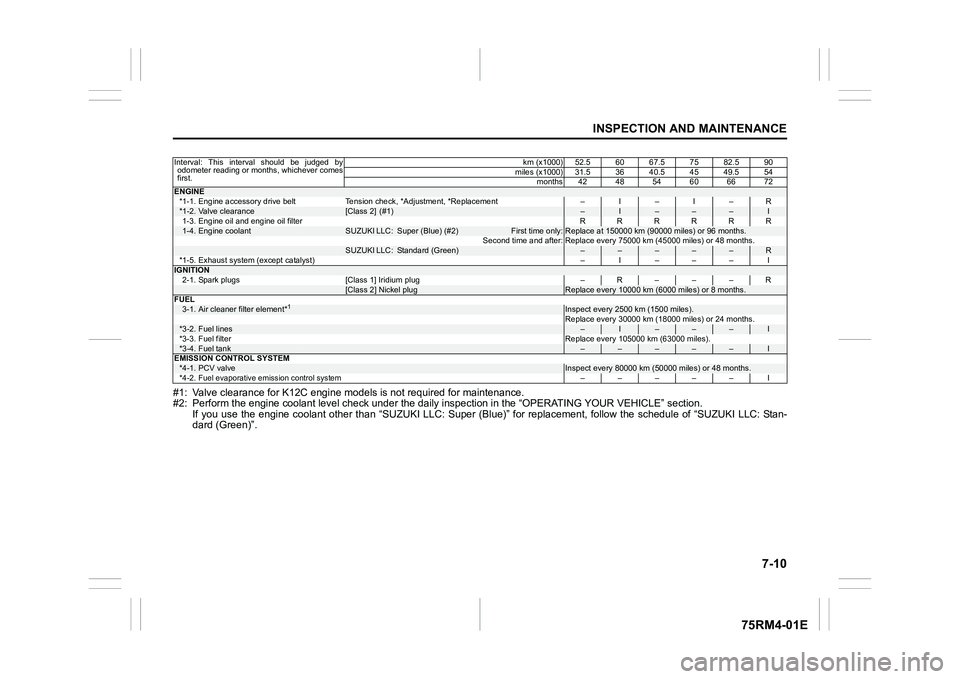
7-10
INSPECTION AND MAINTENANCE
75RM4-01E
#1: Valve clearance for K12C engine models is not required for maintenance.
#2: Perform the engine coolant l evel check under the daily inspection in the “OPERATING YOUR VEHICLE” section.
If you use the engine coolant other than “SUZUKI LLC: Super (Bl ue)” for replacement, follow the schedule of “SUZUKI LLC: Stan-
dard (Green)”.Interval: This interval should be judged by odometer reading or months, whichever comes
first. km (x1000) 52.5 60 67.5 75 82.5 90
miles (x1000) 31.5 36 40.5 45 49.5 54 months 42 48 54 60 66 72ENGINE*1-1. Engine accessory drive belt Tension check, *Adjustment, *Re placement – I – I – R*1-2.
Valve clearance
[Class 2] (#1)
–
I
–
–
–
I
1-3. Engine oil and engine oil filter RRRRRR
1-4.
Engine coolant
SUZUKI LLC:
Super (Blue) (#2)
First time only:
Replace at 150000 km (90000 miles) or 96 months.
Second time and after: Replace every 75000 km (45000 miles) or 48 months.
SUZUKI LLC:
Standard (Green)
–
–
–
–
–
R
*1-5. Exhaust system (except catalyst) – I ––– I
IGNITION
2-1. Spark plugs [Class 1] Iridium plug – R – – – R
[Class 2] Nickel plug
Replace every 10000 km (6000 miles) or 8 months.
FUEL
3-1.
Air cleaner filter element*
1
Inspect every 2500 km (1500 miles).
Replace every 30000 km (18000 miles) or 24 months.
*3-2.
Fuel lines
–
I
–
–
–
I
*3-3. Fuel filter Replace every 105000 km (63000 miles).
*3-4.
Fuel tank
–
–
–
–
–
I
EMISSION CONTROL SYSTEM
*4-1.
PCV valve
Inspect every 80000 km (5 0000 miles) or 48 months.
*4-2.
Fuel evaporative emi ssion control system
––––– I
Page 373 of 505
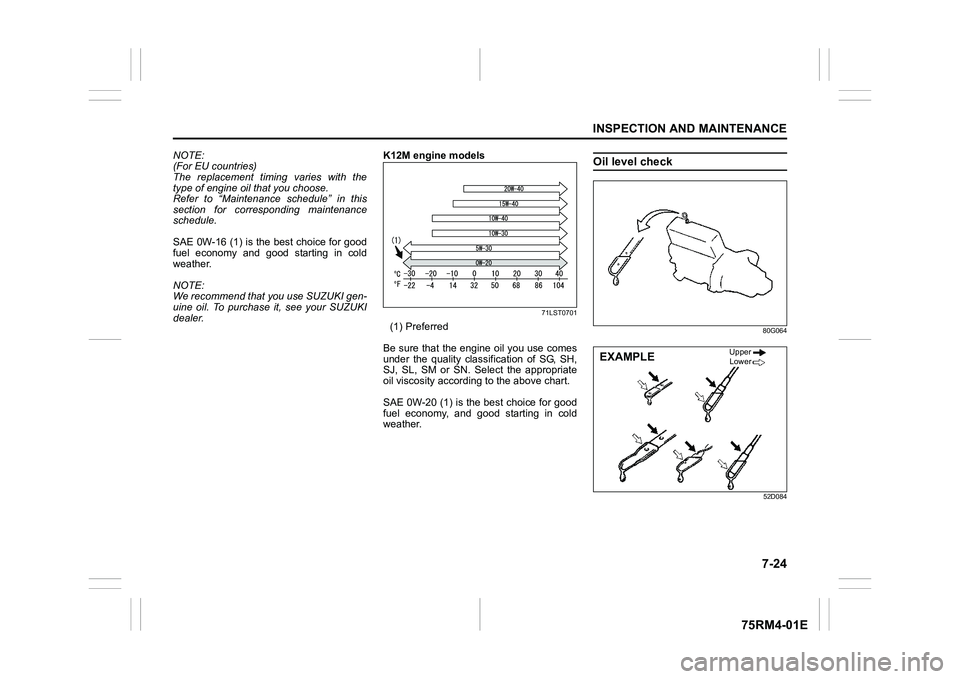
7-24
INSPECTION AND MAINTENANCE
75RM4-01E
NOTE:
(For EU countries)
The replacement timing varies with the
type of engine oil that you choose.
Refer to “Maintenance schedule” in this
section for corresponding maintenance
schedule.
SAE 0W-16 (1) is the best choice for good
fuel economy and good starting in cold
weather.
NOTE:
We recommend that you use SUZUKI gen-
uine oil. To purchase it, see your SUZUKI
dealer. K12M engine models
71LST0701
(1) Preferred
Be sure that the engine oil you use comes
under the quality classification of SG, SH,
SJ, SL, SM or SN. Select the appropriate
oil viscosity according to the above chart.
SAE 0W-20 (1) is the best choice for good
fuel economy, and good starting in cold
weather.
Oil level check
80G064
52D084
EXAMPLE
UpperLower
Page 381 of 505

7-32
INSPECTION AND MAINTENANCE
75RM4-01E
54G106
Spark plug gap “a”
ILZKR6F11:
1.0 – 1.1 mm (0.039 – 0.043 in.)
(For K12M engine model)
Since special procedures, materials and
tools are required, it is recommended that
you trust this job to your authorized
SUZUKI dealer.
Continuously variable transaxle (CVT) fluidSpecified fluidUse a CVT fluid SUZUKI CVT FLUID
GREEN-2.Fluid level checkYou must check the fluid level with the CVT
fluid at normal ope rating temperature.
To check the fluid level:
1) To warm up the CVT fluid, drive the vehicle for more 5 km. NOTE:
Do not check the fluid level if you have just
driven the vehicle for a long time at high
speed, or if you have driven in city traffic in
hot weather, or if the vehicle has been pull-
ing a trailer. Wait until the fluid cools down
(about 30 minutes), or the fluid level indi-
cation will not be correct.
2) Park your vehicle on level ground.
3) Apply the parking brake and then start
the engine in “P” (Park). Let it idle for
two minutes and keep it running during
the fluid level check.
4) With your foot on the brake pedal,
move the gearshift lever through each
gear, pausing for about three seconds
in each range. Then move it back to the
“P” (Park) position.
NOTICE
When replacing spark plugs, you
should use the brand and type speci-
fied for your vehicle. For the specified
plugs, refer to “SPECIFICATIONS”
section in the end of this book. If you
wish to use a brand of spark plug
other than the specified plugs, con-
sult your SUZUKI dealer.
NOTICE
Driving with too much or too little
fluid can damage the transaxle.
NOTICE
Be sure to use the specified CVT
fluid. Using CVT fluid other than
SUZUKI CVT FLUID GREEN-2 may
damage the CVT of your vehicle.
WA R N I N G
Be sure to depress the brake pedal
when moving the gearshift lever, or
the vehicle can move suddenly.
Page 400 of 505
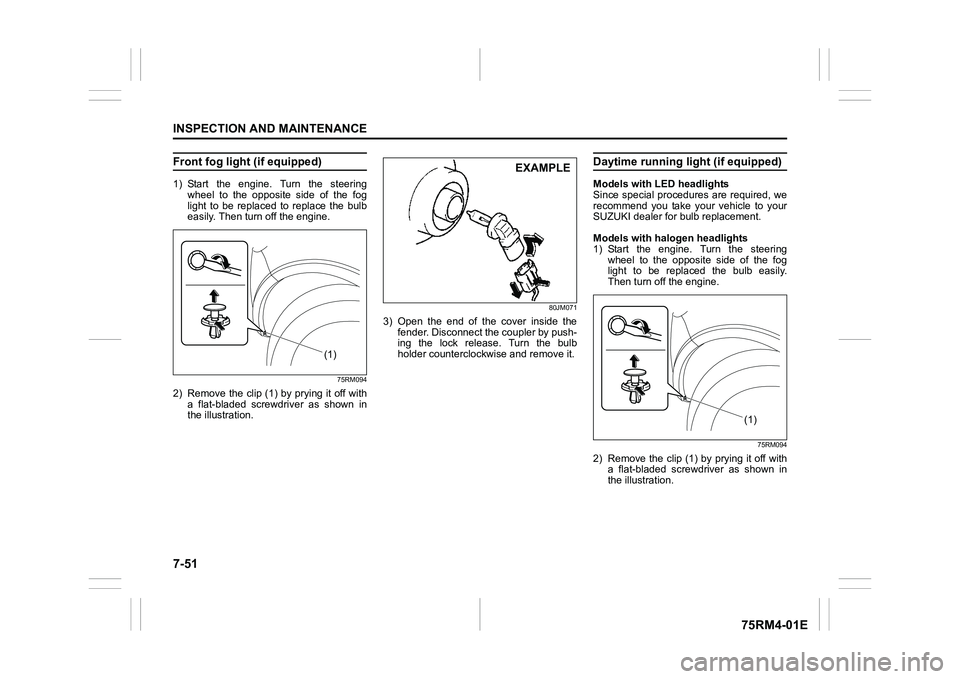
7-51INSPECTION AND MAINTENANCE
75RM4-01E
Front fog light (if equipped)1) Start the engine. Turn the steeringwheel to the opposite side of the fog
light to be replaced to replace the bulb
easily. Then turn off the engine.
75RM094
2) Remove the clip (1) by prying it off witha flat-bladed screwdriver as shown in
the illustration.
80JM071
3) Open the end of the cover inside thefender. Disconnect the coupler by push-
ing the lock release. Turn the bulb
holder counterclockwise and remove it.
Daytime running light (if equipped)Models with LED headlights
Since special procedures are required, we
recommend you take your vehicle to your
SUZUKI dealer for bulb replacement.
Models with halogen headlights
1) Start the engine. Turn the steering
wheel to the opposite side of the fog
light to be replaced the bulb easily.
Then turn off the engine.
75RM094
2) Remove the clip (1) by prying it off witha flat-bladed screwdriver as shown in
the illustration.
(1)
EXAMPLE
(1F
Page 420 of 505

8-11EMERGENCY SERVICE
75RM4-01E
54P000804
3) Connect jump leads as follows:1. Connect one end of the first jumplead to the positive (+) terminal of
the flat battery (1).
2. Connect the other end to the positive (+) terminal of the booster battery
(2).
3. Connect one end of the second jump lead to the negative (–) terminal of
the booster battery (2).
4. Make the final connection to an unpainted, heavy metal part (i.e.
engine mount bracket (3)) of the
engine of the vehicle with the flat
battery (1). 4) If the booster battery you are using is
fitted to another vehicle, start the
engine of the vehicle with the booster
battery. Run the engine at moderate
speed.
5) Start the engine of the vehicle with the flat battery.
6) Remove the jump leads in the exact reverse order in which you connected
them.
TowingIf you need to have your vehicle towed,
contact a professional service. Your dealer
can provide you with detailed towing
instructions.
(2)
(1)
(3)
EXAMPLE
WA R N I N G
Never connect the jump lead directly
to the negative (–) terminal of the dis-
charged battery, or an explosion may
occur.
CAUTION
Connect the jump l ead to the engine
mount bracket securely. If the jump
lead disconnects from the engine
mount bracket because of vibration
at the start of the engine, the jump
lead could be caught in the drive
belts.
WA R N I N G
For vehicles equipped with the dual
camera brake support, if your vehicle
is towed with the engine on, press
dual camera brake support OFF
switch and turn off the dual camera
brake support. If not, unexpected
accidents related to the system being
turned on may occur.
NOTICE
Observe the following instructions
when towing your vehicle.
• To help avoid damage to your vehi- cle during towing, proper equip-
ment and towing procedures must
be used.
• Using the frame hook, tow your
vehicle on paved roads for short
distances at low speed.
Page 422 of 505
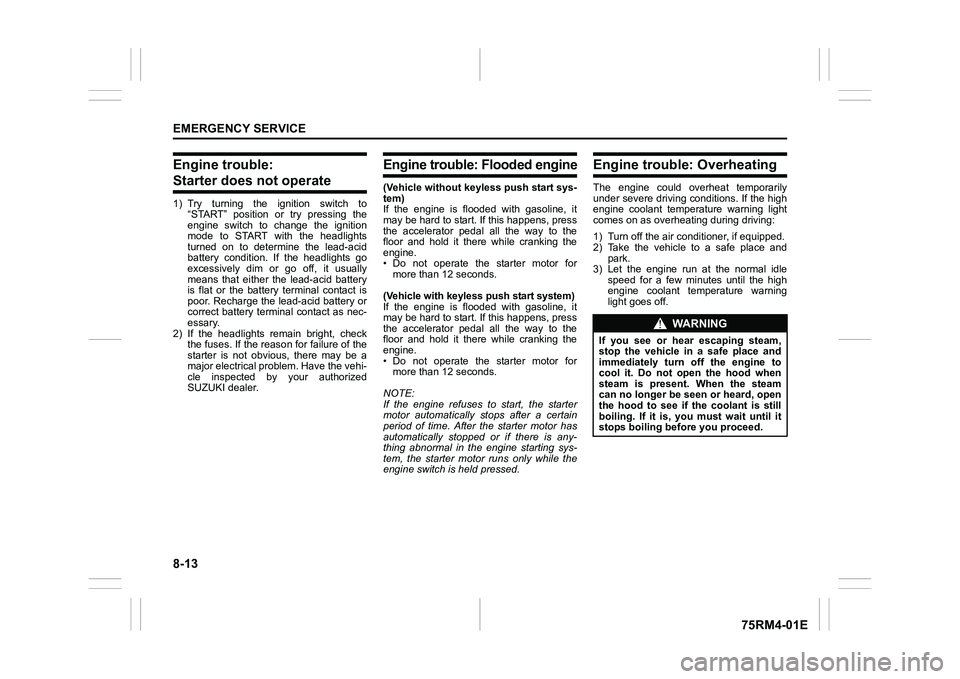
8-13EMERGENCY SERVICE
75RM4-01E
Engine trouble: Starter does not operate1) Try turning the ignition switch to“START” position or try pressing the
engine switch to change the ignition
mode to START with the headlights
turned on to determine the lead-acid
battery condition. If the headlights go
excessively dim or go off, it usually
means that either the lead-acid battery
is flat or the battery terminal contact is
poor. Recharge the lead-acid battery or
correct battery terminal contact as nec-
essary.
2) If the headlights remain bright, check the fuses. If the reas on for failure of the
starter is not obvious, there may be a
major electrical problem. Have the vehi-
cle inspected by your authorized
SUZUKI dealer.
Engine trouble: Flooded engine(Vehicle without keyless push start sys-
tem)
If the engine is flooded with gasoline, it
may be hard to start. If this happens, press
the accelerator pedal all the way to the
floor and hold it there while cranking the
engine.
• Do not operate the starter motor for more than 12 seconds.
(Vehicle with keyless push start system)
If the engine is flooded with gasoline, it
may be hard to start. If this happens, press
the accelerator pedal all the way to the
floor and hold it there while cranking the
engine.
• Do not operate the starter motor for more than 12 seconds.
NOTE:
If the engine refuses to start, the starter
motor automatically stops after a certain
period of time. After the starter motor has
automatically stopped or if there is any-
thing abnormal in the engine starting sys-
tem, the starter motor runs only while the
engine switch is held pressed.
Engine trouble: OverheatingThe engine could overheat temporarily
under severe driving conditions. If the high
engine coolant temperature warning light
comes on as overheating during driving:
1) Turn off the air conditioner, if equipped.
2) Take the vehicle to a safe place and park.
3) Let the engine run at the normal idle speed for a few minutes until the high
engine coolant temperature warning
light goes off.
WA R N I N G
If you see or hear escaping steam,
stop the vehicle in a safe place and
immediately turn off the engine to
cool it. Do not open the hood when
steam is present. When the steam
can no longer be seen or heard, open
the hood to see if the coolant is still
boiling. If it is, you must wait until it
stops boiling before you proceed.
Page 427 of 505
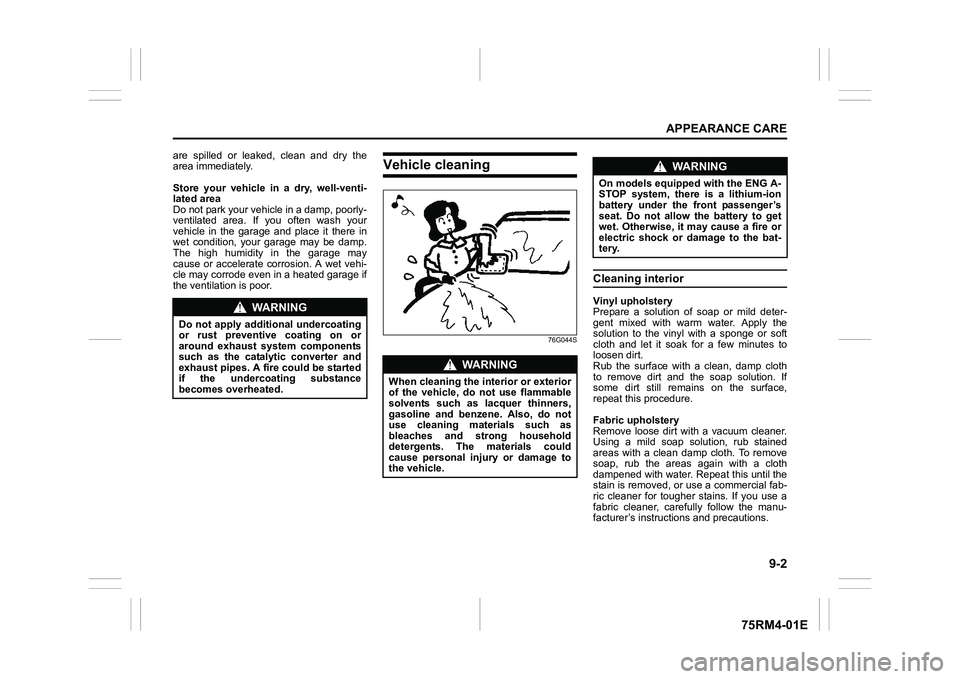
9-2
APPEARANCE CARE
75RM4-01E
are spilled or leaked, clean and dry the
area immediately.
Store your vehicle in a dry, well-venti-
lated area
Do not park your vehicle in a damp, poorly-
ventilated area. If you often wash your
vehicle in the garage and place it there in
wet condition, your garage may be damp.
The high humidity in the garage may
cause or accelerate corrosion. A wet vehi-
cle may corrode even in a heated garage if
the ventilation is poor.
Vehicle cleaning
76G044S
Cleaning interiorVinyl upholstery
Prepare a solution of soap or mild deter-
gent mixed with warm water. Apply the
solution to the vinyl with a sponge or soft
cloth and let it soak for a few minutes to
loosen dirt.
Rub the surface with a clean, damp cloth
to remove dirt and the soap solution. If
some dirt still remains on the surface,
repeat this procedure.
Fabric upholstery
Remove loose dirt with a vacuum cleaner.
Using a mild soap solution, rub stained
areas with a clean damp cloth. To remove
soap, rub the areas again with a cloth
dampened with water. Repeat this until the
stain is removed, or use a commercial fab-
ric cleaner for tougher stains. If you use a
fabric cleaner, carefully follow the manu-
facturer’s instructions and precautions.
WA R N I N G
Do not apply additional undercoating
or rust preventive coating on or
around exhaust system components
such as the catalytic converter and
exhaust pipes. A fire could be started
if the undercoating substance
becomes overheated.
WA R N I N G
When cleaning the interior or exterior
of the vehicle, do not use flammable
solvents such as lacquer thinners,
gasoline and benzene. Also, do not
use cleaning materials such as
bleaches and strong household
detergents. The materials could
cause personal injury or damage to
the vehicle.
WA R N I N G
On models equipped with the ENG A-
STOP system, there is a lithium-ion
battery under the front passenger’s
seat. Do not allow the battery to get
wet. Otherwise, it may cause a fire or
electric shock or damage to the bat-
tery.
Page 437 of 505
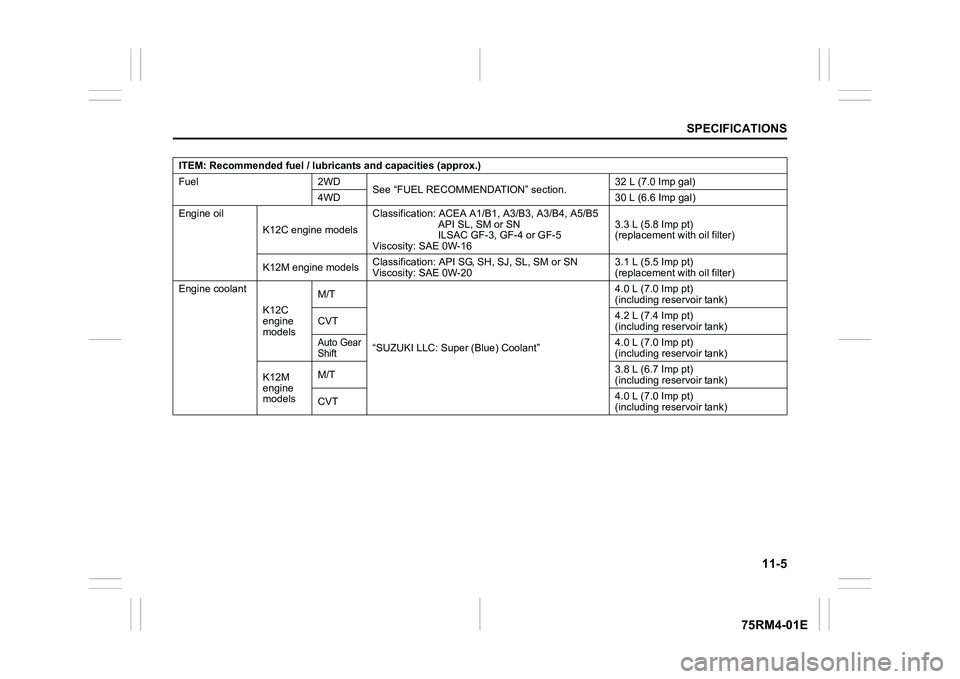
11-5
SPECIFICATIONS
75RM4-01E
ITEM: Recommended fuel / lubricants and capacities (approx.)
Fuel 2WD See “FUEL RECOMMENDATION” section. 32 L (7.0 Imp gal)
4WD 30 L (6.6 Imp gal)
Engine oil
K12C engine models Classification: ACEA A1/B
1, A3/B3, A3/B4, A5/B5
API SL, SM or SN
ILSAC GF-3, GF-4 or GF-5
Viscosity: SAE 0W-16 3.3 L (5.8 Imp pt)
(replacement with oil filter)
K12M engine models Classification: API SG,
SH, SJ, SL, SM or SN
Viscosity: SAE 0W-20 3.1 L (5.5 Imp pt)
(replacement with oil filter)
Engine coolant
K12C
engine
modelsM/T
“SUZUKI LLC: Super (Blue) Coolant” 4.0 L (7.0 Imp pt)
(including reservoir tank)
CVT 4.2 L (7.4 Imp pt)
(including reservoir tank)
Auto Gear
Shift
4.0 L (7.0 Imp pt)
(including reservoir tank)
K12M
engine
models M/T
3.8 L (6.7 Imp pt)
(including reservoir tank)
CVT 4.0 L (7.0 Imp pt)
(including reservoir tank)
Page 444 of 505
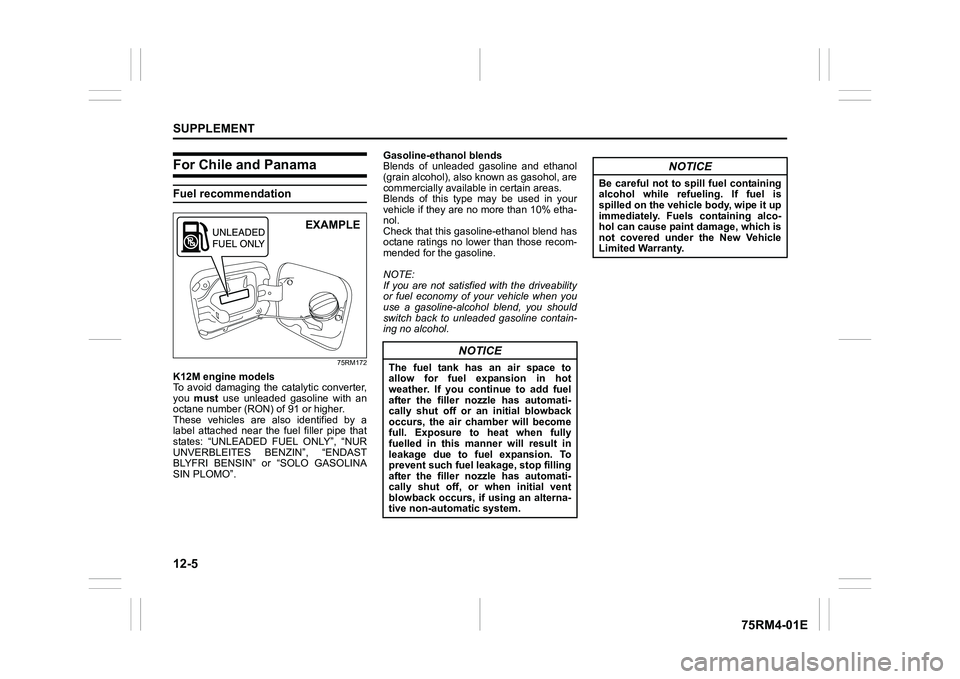
12-5SUPPLEMENT
75RM4-01E
For Chile and PanamaFuel recommendation
75RM172
K12M engine models
To avoid damaging the catalytic converter,
you must use unleaded gasoline with an
octane number (RON) of 91 or higher.
These vehicles are also identified by a
label attached near the fuel filler pipe that
states: “UNLEADED FUEL ONLY”, “NUR
UNVERBLEITES BENZIN”, “ENDAST
BLYFRI BENSIN” or “SOLO GASOLINA
SIN PLOMO”. Gasoline-ethanol blends
Blends of unleaded gasoline and ethanol
(grain alcohol), also known as gasohol, are
commercially available in certain areas.
Blends of this type may be used in your
vehicle if they are no more than 10% etha-
nol.
Check that this gasoline-ethanol blend has
octane ratings no lower than those recom-
mended for the gasoline.
NOTE:
If you are not satisfied with the driveability
or fuel economy of your vehicle when you
use a gasoline-alcohol blend, you should
switch back to unleaded gasoline contain-
ing no alcohol.
EXAMPLE
NOTICE
The fuel tank has an air space to
allow for fuel expansion in hot
weather. If you continue to add fuel
after the filler nozzle has automati-
cally shut off or an initial blowback
occurs, the air chamber will become
full. Exposure to heat when fully
fuelled in this manner will result in
leakage due to fuel expansion. To
prevent such fuel leakage, stop filling
after the filler nozzle has automati-
cally shut off, or when initial vent
blowback occurs, if using an alterna-
tive non-automatic system.
NOTICE
Be careful not to spill fuel containing
alcohol while refueling. If fuel is
spilled on the vehicle body, wipe it up
immediately. Fuels containing alco-
hol can cause paint damage, which is
not covered under the New Vehicle
Limited Warranty.
Page 447 of 505
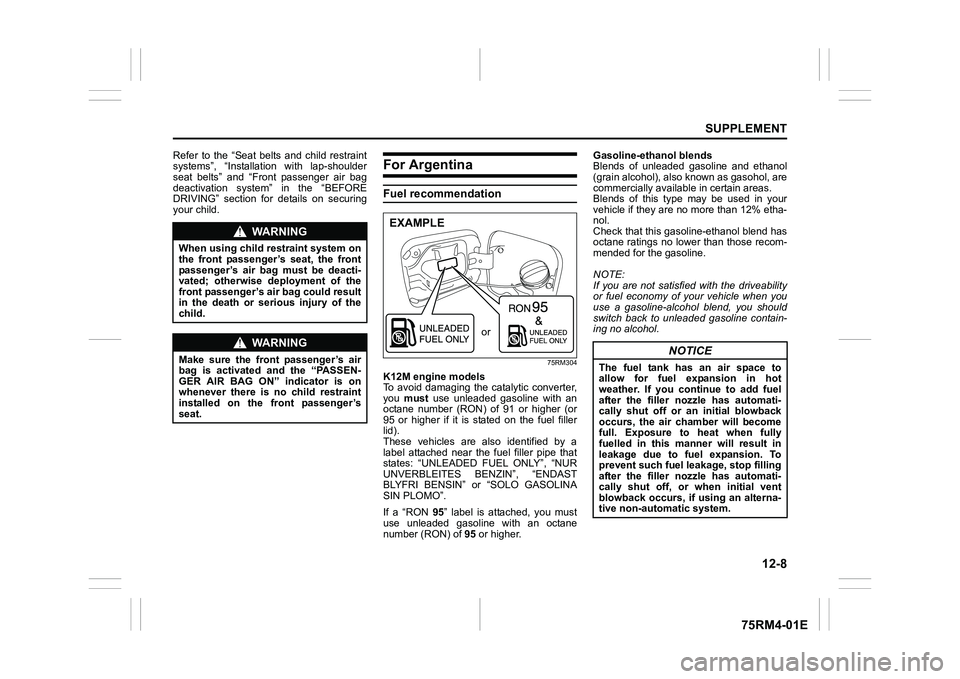
12-8
SUPPLEMENT
75RM4-01E
Refer to the “Seat belts and child restraint
systems”, “Installation with lap-shoulder
seat belts” and “Front passenger air bag
deactivation system” in the “BEFORE
DRIVING” section for details on securing
your child.
For ArgentinaFuel recommendation
75RM304
K12M engine models
To avoid damaging the catalytic converter,
you must use unleaded gasoline with an
octane number (RON) of 91 or higher (or
95 or higher if it is stated on the fuel filler
lid).
These vehicles are also identified by a
label attached near the fuel filler pipe that
states: “UNLEADED FUEL ONLY”, “NUR
UNVERBLEITES BENZIN”, “ENDAST
BLYFRI BENSIN” or “SOLO GASOLINA
SIN PLOMO”.
If a “RON 95” label is attached, you must
use unleaded gasoline with an octane
number (RON) of 95 or higher. Gasoline-ethanol blends
Blends of unleaded gasoline and ethanol
(grain alcohol), also known as gasohol, are
commercially available in certain areas.
Blends of this type may be used in your
vehicle if they are no more than 12% etha-
nol.
Check that this gasoline-ethanol blend has
octane ratings no lower than those recom-
mended for the gasoline.
NOTE:
If you are not satisfied with the driveability
or fuel economy of your vehicle when you
use a gasoline-alcohol blend, you should
switch back to unleaded gasoline contain-
ing no alcohol.
WA R N I N G
When using child restraint system on
the front passenger’s seat, the front
passenger’s air bag must be deacti-
vated; otherwise deployment of the
front passenger’s air bag could result
in the death or serious injury of the
child.
WA R N I N G
Make sure the front passenger’s air
bag is activated and the “PASSEN-
GER AIR BAG ON” indicator is on
whenever there is no child restraint
installed on the front passenger’s
seat.
or
EXAMPLE
NOTICE
The fuel tank has an air space to
allow for fuel expansion in hot
weather. If you continue to add fuel
after the filler nozzle has automati-
cally shut off or an initial blowback
occurs, the air chamber will become
full. Exposure to heat when fully
fuelled in this manner will result in
leakage due to fuel expansion. To
prevent such fuel leakage, stop filling
after the filler nozzle has automati-
cally shut off, or when initial vent
blowback occurs, if using an alterna-
tive non-autom
atic system.